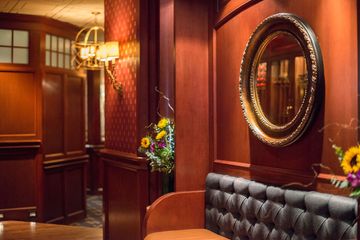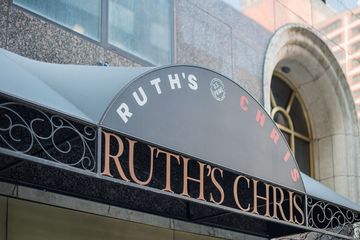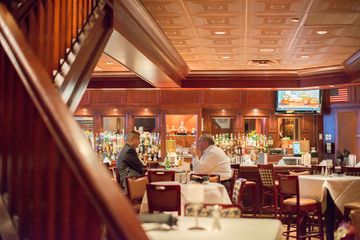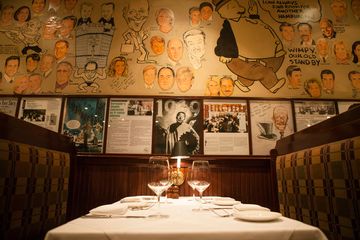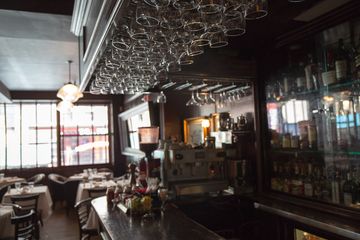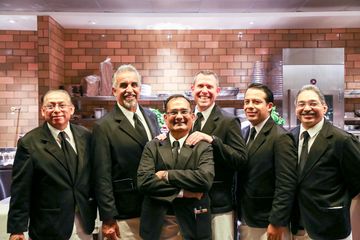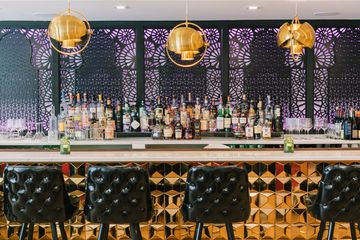Upon entering the Palm, one can tell it lives and breathes New York. Whether it is the famous caricatures on the walls, the rich mahogany leather high chairs, the sizzling steaks or the unmistakable din of a successful New York City restaurant, the Palm has each and every trait of a staple. It is a restaurant where tradition is paramount and regulars are treated like family. Opened by Italian immigrants Pio Bozzi and John Ganzi on the east side in 1926, the restaurant has been family-owned from its inception. Surprisingly, the Palm began as somewhat of an accident. Bozzi and Ganzi intended to call their traditional Italian restaurant La Parma but, with their thick Italian accents, the city licensing clerk misunderstood. And so, the restaurant's name – and trademark – was born. The original location, on Second Avenue at 45th Street, served as a lunch and dinner club for members of the city's newspapers, whose offices were located within a few blocks of the restaurant. It was here that my husband first discovered the Palm some forty years ago with his college roommate. He recalls how the mustachioed maître d' took no names but remembered everyone in order, and being excited by seeing the fight promoter, Don King, at the very next table. Ever since, my husband has revered the Palm, particularly the softball-sized juicy filet mignons served charred on the outside and perfect-to-order on the inside. Four generations after Bozzi and Ganzi opened their restaurant, most of the Palm's traditions remain intact. The West 50th Street setting is true to the Palm's roots. Hospitality and consistency of service and quality of food is the mantra the Palm lives by, according to General Manager Richard Hammel. And while the city, and especially the neighborhood surrounding the restaurant, rapidly changes, the Palm serves as a reminder that tradition still sells. As Hammel said, "Hospitality knows no age. "When Lucy and Casey, two members of the Manhattan Sideways team, visited The Palm in November 2016, they had the pleasure of taking a tour with Robert, the restaurant’s hospitable and enthusiastic sales manager. He explained that the crowd is a mix of businesspeople, theatergoers, and families. Celebrities, politicians, and sports figures, many of whom are featured in The Palm’s constantly expanding collection of wall caricatures, can also regularly be spotted in one of The Palm’s dining rooms. (In the past, there was a "sing for your supper" policy - an artist could enjoy a free meal by drawing a portrait for the wall). When Robert first started working at the Palm three years ago, nobody wanted their faces on the back wall. Then, Robert added Hugh Jackman, who was performing in “The River” across the street, and the back wall suddenly became the spot to be for Broadway actors. Now, “Robert’s Wall” is filled with the caricatures of Broadway’s stars and their autographs. The Palm’s walls feature famous people alongside lesser-known faces and, in Robert’s words, “people we just love. ” If there’s a signature under a caricature, you know that person has visited The Palm. The Palm is all about loyalty. An estimated forty percent of its customers are return guests, according to Hammel, in part because of the 837 Club, the loyalty club that provides guests with points for dining there. But while regulars provide a large chunk of its business, there has been a surge of younger guests and tourists in the past few years. This is partly due to the new specialty drink and cocktail menu, intended to shake things up and diversify the clientele. Even Hammel admitted: "the Palm is still a men's club at times. " But the Palm is not afraid to adapt to changing times and, as Hammel said, "consistency and staying the same are different. "While the photographer was taking shots of the restaurant and the food, I also struck up an endearing conversation with Armando, a waiter who has been working at the Palm since this location's opening in 1989. He was standing below a caricature of Sarah Jessica Parker. A swirly cursive note next to her face read: "Just simply the only place for 'the folks. ' Much love and luck. SJP. "
